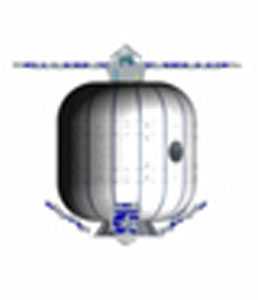Thank you very much for visiting Gunter's Space Page. I hope that this site is useful and informative for you.
If you appreciate the information provided on this site, please consider supporting my work by making a simple and secure donation via PayPal. Please help to run the website and keep everything free of charge. Thank you very much.
Galaxy

Galaxy [Bigelow Aerospace]
Galaxy is a technology demonstration for the inflatable Nautilus space station structure as a prototype for a space hotel by Bigelow Aerospace.
Bigelow Aerospace has kicked off development of the Galaxy advanced technology demonstration program, which is intended to be launch-ready in the fall of 2008.
Galaxy will bridge the evolutionary development between the Genesis-class vehicles and the vehicle to follow – Bigelows first human-inhabitable module, Sundancer. Galaxy's primary purpose is to provide critical risk reduction, as well as first-flight experience for technologies being developed and intended to be flown on Sundancer and the operational fleet of standard-sized vehicles.
While Bigelow will leverage proven processes and technology learned in the development and flight of Genesis I and II, a number of technological advances will be implemented on Galaxy. These include:
- Advanced onboard avionics: Features increased performance, reconfigurability, decentralized processing, superior redundancy capabilities and “plug and play” features to speed integration and testing while improving reliability.
- Key elements of the Environmental Control Life Support System (ECLSS): While Galaxy will not need to support human passengers, it serves as an test-bed to flight-qualify critical elements of the life- and crew-support systems in zero-gravity.
- Upgraded attitude determination and control system: The basic Genesis-class guidance, navigation and control system will be upgraded to provide greater torque-control authority and momentum management with precision attitude sensing.
- Increased communications bandwidth: The addition of higher-speed communications bands for uplink and downlink will provide for more responsive commanding, as well as real-time video downlink capability for the first time. To support these enhancements, corresponding upgrades will be made to the ground stations in Nevada, Alaska, and Hawaii.
- An improved, more robust air-barrier: Includes more damage-resistant properties. Human-factor considerations in selection of materials robust enough to support frequent and intensive onboard astronaut activities will be addressed.
- Power system improvements: To include larger and more efficient articulated solar arrays and high-performance battery technologies.
- Structural upgrades: Mass and stiffness efficiency improvements will be made to the primary structure and soft-goods. These improvements will support scalability to the larger spacecraft. The addition of an access hatch and an additional, larger window/viewing port will be incorporated.
Galaxy will also have a 45% larger usable volume than its Genesis precursors.
Galaxy design work and prototyping will extend through 2007, and will be integrated through 2008 in order to support launch readiness in the fall of that year. In August 2007 Bigelow announced, that they do not intend to launch the Galaxy spacecraft due to rising launch costs, although the spacecraft (or at least parts of it) will be built for ground tests. Bigleow will directly move on to launch the Sundancer space station.
| Nation: | USA |
|---|---|
| Type / Application: | Technology, inflateable structures |
| Operator: | Bigelow Aerospace |
| Contractors: | Bigelow Aerospace |
| Equipment: | |
| Configuration: | Inflatable structure 3.3 m inflated diameter (xxx m diameter uninflated), 4.0 m length; 16.7 m3 usable volume |
| Propulsion: | None |
| Power: | 8 deployable fixed solar arrays, batteries |
| Lifetime: | |
| Mass: | |
| Orbit: |
| Satellite | COSPAR | Date | LS | Launch Vehicle | Remarks | |
|---|---|---|---|---|---|---|
| Galaxy | - | cancelled |
References:
- Bigelow Aerospace Website
